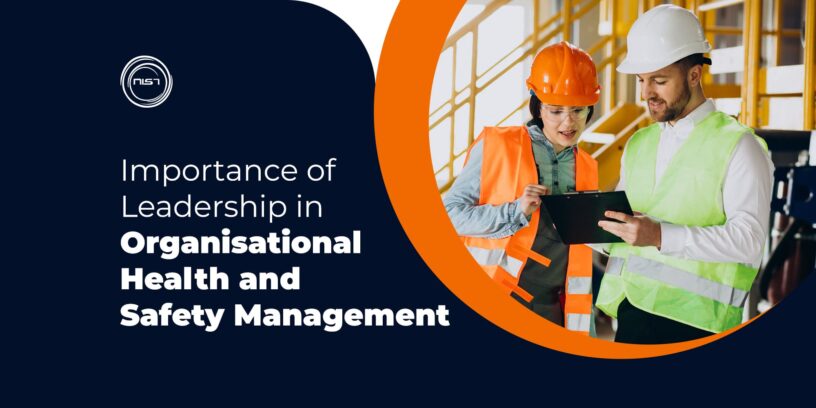Effective leadership can help to create an environment that is safe for workers, customers, and members of the public. Leadership is one of the most important aspects of organisational health and safety management as it duly helps in promoting health and safety within an organisation and has a direct impact on the achievement of an organisation’s objectives, performance and compliance with regulatory requirements.
Moreover, an effective leader could ensure that the goals of an organisation are met and that individuals working within the organisation are able to fulfil their responsibilities. It is also important that good leadership can create a positive workplace culture that supports safety and health. A successful leader in Health and Safety must have a good understanding of the company’s health and safety policy. However, a leader who does not understand the policy may be ineffective in ensuring that employees comply with it. Furthermore, a leader who does not understand the policy may be less likely to take action to prevent accidents.
A busy workplace is always full of hazards. The busy employees working in the office need a leader to show them the way and protect them. It is a well-known fact that workplace accidents are considered to be one of the major causes of workplace fatalities. These accidents at workplaces can be prevented if proper safety procedures are in place. A good leader could help employees to understand how to safely use equipment, handle hazardous objects, and follow safe practices—all with the aim of preventing accidents. Leadership is important in managing health and safety management inside workplaces.
A good leader helps to develop safety policies, procedures, and training. Implementation of these policies, procedures, and training will ensure safety at workplaces. If no proper safety management is followed, workplace accidents may pose serious risks to individuals, especially to the workers.
Essentialities of a good leader:
Leadership:
A leader guides, influences, motivates, inspires, challenges and educates others so that they can achieve their full potential and perform at a higher level within an organisation.
- A leader sets examples and provides motivation.
- Leaders influence both the positive sides of people’s behaviors, actions and attitudes.
- Good leaders make everyone feel important; this makes individuals feel valued and appreciated.
- Effective leaders inspire others and guide them toward accomplishing goals.
In today’s world, the leaders need to take many other considerations into account when managing safety, such as the environment and the community. Leaders need to ensure that their organisation is not only a place where employees are safe to work but a good place for its clients and the community.
One of the most valuable attribute of a leader in managing an organization’s health and safety is the ability to assure safety at all times. As a result, the leader is accountable for ensuring that nothing is put in place that could jeopardise the safety of the organization’s workers and clients. They must evaluate the risk rather than merely leaving it up to people in charge of managing safety.
Leaders are to set the vision, strategy and policies; make the right risk decisions; set and be accountable for the risk culture; work with the organisation’s people, processes, information and technology to deliver safety; and assure the safety of the people of the organisation. Leaders must also drive the safety agenda in the organisation, and be available when required to provide advice and guidance to their colleagues.
Types of leadership:
There are different types of leadership, each with its own impacts on organisational health and safety management. Effective leadership involves creating a positive atmosphere and inspiring individuals to work towards the goals of the organisation. Leadership styles can vary, but there are five main types of leadership: inspirational, directive, participative, analytical, and reconciling.
To be a successful leader in organisational health and safety management, it is important to understand the different types of leadership and how they impact organisational health and safety. Then, you need to learn how to apply these styles to meet the needs of your organisation. Becoming a good leader in organisational health and safety requires effort and dedication, but it is a key responsibility that is essential for the health and well-being of all individuals working within the organisation.
Benefits:
- An effective leader encourages companies to take proactive steps to prevent accidents from happening.
- Effective leadership encourages employees to report any hazards they discover, puts in place systems and procedures to address safety issues quickly, and rewards those who make ongoing efforts towards safety.
- Successful leadership in Health and Safety can help an organisation improve its safety performance.
- A good leader ensures that all employees are aware of the company’s health and safety policy and that they comply with it.
- A good leader can motivate employees to take action to prevent accidents, and can provide support and feedback to those who do take action.
- A good leader will be aware of the individual roles and responsibilities of employees.
- He will be able to understand the need for each employee to take action to prevent accidents
- A good leader would provide feedback to employees on their actions
Leaders play an essential role in guiding their subordinates to act responsibly and protect themselves from harm. Good leadership can create a positive workplace culture that supports safety and health.
Learning outcomes:
Health and safety leadership training would enable learners to:
- Plan, organize, manage, and control a team or department within an organisation
- Be able to prepare for career development opportunities and move up in the organisation
- Provide learners with a clear understanding of how they can contribute productively at work
- Equip learners with the abilities to lead others, motivate people
- Build and promote a shared H&S vision
- Be able to articulate the purpose of the organisation;
- Be able to clearly communicate what the organisation stands for
- Have effective communication skills that include listening well and demonstrating empathy
- Be an effective collaborator – working collaboratively and as part of a team
- Be an inspiring leader – communicating a clear sense of direction and a compelling vision to all those involved in the business or project
- Understand yourself well enough to be able to lead your own life and work effectively
We would also cover the following:
Who are Health & Safety leaders?
What are their roles and responsibilities?
What is Leadership Communication?
Why is it important for the Health & Safety Leader to be able to communicate effectively with their team?
What skills should they develop?
What is an effective team?
How can we work together as one team?
What is the difference between Management and Leadership?
What is an organisation’s ‘culture’?
What is a ‘safety culture’?
Why NIST?
Our training is available in both online and classroom delivery modes which can be customized according to the requirements of the organization. Leadership is the most important factor that drives organizational success or failure and this course will provide you with the skills and tools to become a better leader and take your leadership style to new heights This course is designed by experts and aimed at all levels of leaders (supervisors, managers and executives) who want to build on their current level of understanding to gain deeper knowledge of how they can develop a more effective leadership style. Happy Learning! For more information, please contact our client service team at +91 9384663536 or send an email to corporate.sales@nistinstitute.com.














Leave a Reply